Essential Accessories for Your Pet Bird's Cage
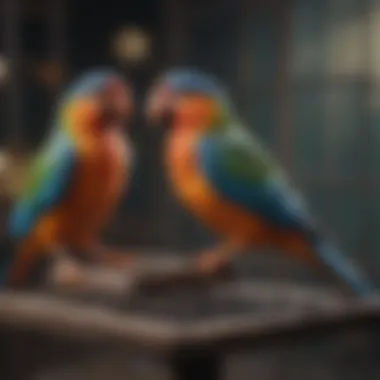
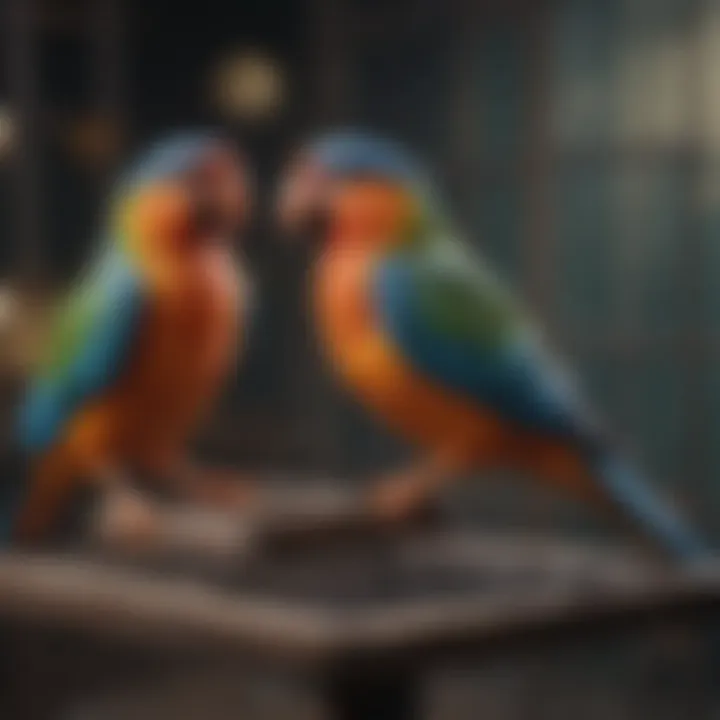
Intro
Owning a pet bird brings unique joys and responsibilities. Birds are not just mere companions; they require a nurturing environment that contributes to their well-being and happiness. This article provides insight into essential accessories for bird cages, aiming to enhance the lives of both the avian companions and their human caretakers. Proper accessories play a vital role in a bird's health, cognitive stimulation, and social needs. Understanding which accessories to incorporate can make a palpable difference in the lives of your feathered friends.
Care Tips
Ensuring the comfort and safety of your pet bird starts with daily care routines. These routines encompass various tasks, such as feeding, cleaning, and nurturing your bird's mental health. Creating a sustained environment with interactive toys, perches, and proper nutrition will help your pet thrive.
Daily Care Routines
Daily engagement is crucial for a bird's physical and emotional health. Feed your bird a balanced diet rich in seeds, fruits, and vegetables. Clean the cage frequently to remove droppings and leftover food. Spend quality time with your bird outside the cage; this will build trust and strengthen your bond.
Cage Setup and Maintenance
The cage should be spacious and designed to mimic a bird’s natural habitat as much as possible. Choose the right size to allow enough movement, and consider materials that are safe, avoiding those coated with toxic substances. Organize the cage with a selection of perches, toys, and feeding stations at varying heights to stimulate activity.
Hygiene and Cleaning Practices
Hygiene in a bird's enclosure cannot be compromised. Clean all surfaces, toys, and perches regularly using bird-safe cleaning solutions. The frequency of these cleaning practices usually depends on the number of birds and the size of the cage, but thorough cleaning at least weekly is beneficial.
Seasonal Care Adjustments
Changes in seasons require adjustments to care practices. During winter months, consider providing extra bedding and limiting drafts. In contrast, ensure summer humidity does not excessively rise, as birds can become stressed in high temperatures. Watch for changes in your bird's behavior to identify when seasonal modifications are necessary.
Ensuring your bird's environment is clean and adapted to seasonal changes is crucial for their overall well-being.
Behavioral Insights
To foster a harmonious atmosphere you must understand your bird's behavior and personality. Birds communicate through body language and vocalizations which can indicate their emotional state.
Understanding Bird Body Language
Birds often display specific physical indicators of their feelings. Elevated feathers might signify excitement, while a puffed-up posture can represent a need for comfort. Observing these signs helps you respond to their needs accurately.
Common Behavioral Issues and Solutions
Behavioural issues are common among pet birds that often stem from boredom or frustration. Common problems include excessive screaming or feather plucking. To resolve these issues, analyze their environment and add engaging activities and stimulation.
Positive Reinforcement Techniques
Step forward with Positive reinforcement which encourages desirable behaviors in birds. Reward good behaviour with treats or praise. This creates a positive connection between the action and the reward, essential for guiding your country of educating your bird.
Social Interaction Needs
Birds, being social animals, require adequate human interaction and sometimes, companionship from their own species. Guaranteeing they have friends maintains good mental health, so consider these social needs while arranging their living conditions.
Nutrition Guides
A well-balanced diet is integral to a pet bird's health. Not all birds share the same diet, depending on species, size, and age. Therefore knowing your specific bird’s dietary needs is crucial for providing it adequate nutrition.
Essential Diet Components
Base the diet primarily on high-quality pellets that encompass comprehensive nutrition. Include fresh fruits and vegetables to complement their meals adequately.
Safe and Toxic Foods
Not every food is safe for bird consumption. Some common safe foods include small amounts of bananas and broccoli. Barley and avocado, however, are toxic and must be avoided completely. Many birds require a specialist’s advice to navigate through their nutritional needs.
Supplements and Treats
Feeling adequate supplementation is desirable. Calcium supplements or vitamin-rich treats can improve overall health, particularly in breeding or aging birds.
Feeding Strategies for Different Species
Know your bird species to choose appropriate feeding strategies. For example, obese birds require measured quantities of seeds, while smaller birds like budgies will benefit from a varied diet of pellets alongside fresh produce.
Wellness and Health
Routine health checks and understanding early signs of illness is vital. Regular veterinary visits allow for surveillance on health issues.
Routine Health Checkups
It is wise to schedule routine checkups with avian veterinarians. Regular evaluations keep your bird thriving and help in early detection of health issues.
Identifying Symptoms of Illness
Identifying unusual behaviours or physical symptoms can signal underlying health issues. Pay attention to changes in eating, chirping, or activity levels.
Preventative Care and Vaccinations
Regular vaccinations and preventive healthcare are essential. Following up with veterinarian recommendations will lower the risk of potential diseases hitting your avian companions.
Mental and Emotional Well-being
Avian health is not just physical; mental wellness is equally as substantial. Engaging activities and social interaction significantly contribute to a bird's emotional stability.
Enriching Activities
Bird cages can feel restricting unless meaningfully set up. Therefore, enriching activities help maintain both physical and mental fitness.
Toys and Playtime Ideas
Interactive toys burgeon avian interest and activity. Provide a mix of foraging toys and interest- piquing objects usually found in natural settings.
Training and Tricks
Each day offers opportunities to train birds to follow simple commands with ease. Prepare treats ahead of time for positive outcomes.
Outdoor Activities and Interaction
Allowing your birds supervised outdoor time enriches their lives. Ensure they have secure setups to prevent escape while soak up some sun.
DIY Projects for Mental Stimulation
Consider embarking on DIY projects to create new toys and diversion objects to include in their cages. Simple projects using household items promote mental agitation.
This overview serves to establish foundational knowledge. Each accessory, care method, and activity ultimately enhances the quality of life for pet birds, ensuring they not only survive but flourish.
Preamble to Pet Bird Cage Accessories
Developing a comfortable and enriching environment for pet birds is not a luxury but a necessity. Pet bird cage accessories play a pivotal role in establishing this setting. They serve not only functional purposes but also contribute significantly to the well-being and mental stimulation of avian companions. Without proper accessories, pet birds may feel bored or stressed. Thus, understanding how to choose the right accessories is crucial for any responsible bird owner.
Importance of Accessories
Accessories are fundamental in crafting a bird's daily experience. They support physical health, encourage natural behavior, and serve mental needs. Birds possess a variety of instinctual behaviors; incorporating the right items allows those behaviors to flourish. For example, perches and hammocks promote climbing and resting activities, while toys can replace boredom and keep the mind active. The accessories in a cage also impede harmful habits by providing alternative outlets for energy and stimulation. Without engaging and appropriate setting, birds may resort to destructive or repetitive actions, such as excessive vocalization or feather plucking.
"Carving out a nurturing space for pet birds is multidimensional, where every accessory helps enrich their quality of life."
Overview of Common Types
A range of accessories exists to enhance the habitats of pet birds. Understanding what is available can assist pet owners in picking what best suits the needs of their birds. Here are key categories to consider:
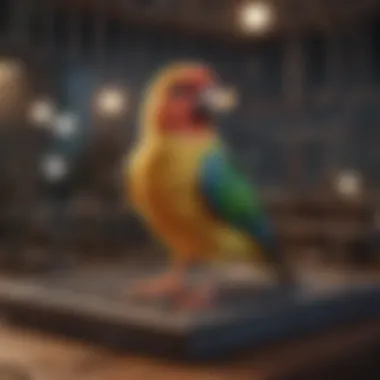
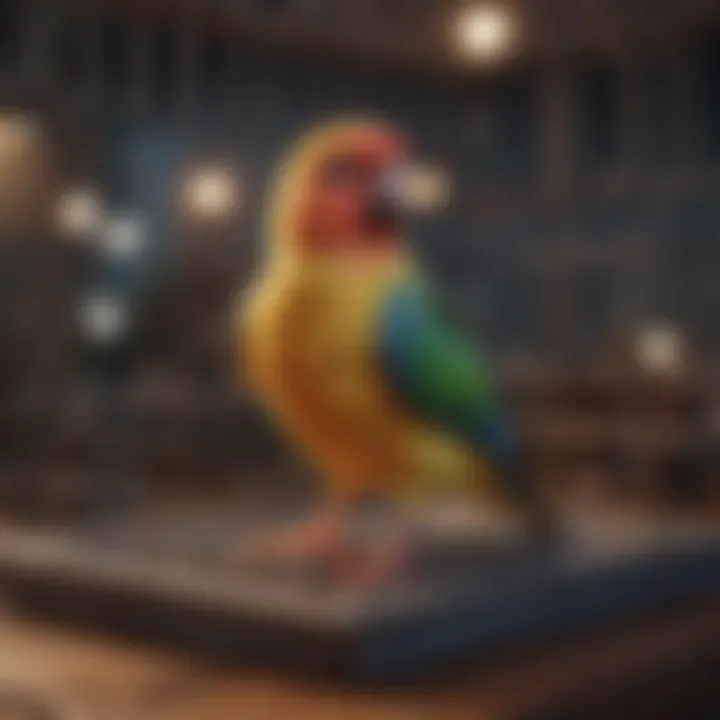
- Cage Liners: These ensure cleanliness and protect the cage floor. They come in various materials and thicknesses, providing comfort for birds.
- Perches: Heights and widths can vary widely, which is key to mimicking birds' natural environments.
- Food and Water Dishes: Select these based on ease of use, safety stability, and cleaning ease. A bird needs proper hydration and nutrition every day.
- Toys: Diverse toys stimulate the mind; thus, consider types that provide different engagement levels.
- Climbing Structures: Incorporating items for climbing enhances exercise and satisfies a bird’s instinctual behaviors.
Enhanced understanding of each type of accessory enables better decision-making, aligning selections with the specific requirements of the bird. Accurately addressing the environmental elements cultivates a sense of safety and comfort in avian pets.
Cage Liners
Cage liners play a vital role in upholding the cleanliness and overall health of your pet bird's habitat. Additionally, they can aid in creating a comfortable and safe space for your avian companion. A consideration of the right cage liner often leads to positive outcomes in managing chirps and satisfaction levels.
Purpose and Benefits
Cage liners serve multiple purposes. Firstly, they act as barriers between your bird and the waste material produced during their daily routines. Without a proper liner, feces can deteriorate the environment within the cage, leading to unpleasant odors and potential health issues. Using cage liners simplifies the cleanup process. You can replace or clean them easily, thus ensuring sanitation standards meet regular practices. Bird owners will notice that their feathered friends are less stressed and more at ease.
Another essential aspect of cage liners is protecting the cage's bottom surface. A suitable liner helps prevent any scratches or damage from the bird's activities. Furthermore, certain types of liners can absorb moisture, reducing the risk of mold and bacteria build-up. This ahead of time protection provides a long-lasting environment.
Recommended Materials
Selecting the right materials for cage liners demands careful thought. You may consider options like paper, cardboard, or even more natural choices such as cloth or aspen shavings. These materials offer different levels of effectiveness when it comes to control of messiness and odor.
- Newspaper: This is one of the most common choices among bird owners due to its affordability and availability. It's easy to cut to size and can absorb moisture fairly well. Regular changing also ensures that the cage remains clean.
- Absorbent Paper Liners: Available in pet supply stores, these liners are often designed specifically for use in bird cages. They feature high absorbency, keeping the cage dry and controlling odors effectively.
- Wood Shavings or Pellets: While many find them appealing due to their natural look, they require more upkeep. Certain types, like cedar, should be avoided as they can be toxic to birds.
- Cage-Specific Fabric Liners: For a more stylish setup, these can be used but must be washed regularly to maintain hygiene standards. Ensuring that they are specifically made for bird cages is essential to avoid safety hazards.
Using the correct material suitable for your bird's needs can positively affect their health and your convenience.
Perches
Perches are an essential component in a pet bird's cage. They provide birds with a place to rest, play, and exercise their feet. Without appropriate perches, pet birds may develop issues such as foot problems or weight gain due to a lack of physical activity. Proper perches support a bird's natural behaviors, mimic their habitats, and contribute significantly to their overall well-being.
Types of Perches
Natural Wood Perches
Natural wood perches are often preferred by bird owners for a number of reasons. These perches not only imitate what wild birds would use in their natural habitat but also provide variety for the birds’ feet. An important aspect of natural wood perches is their varying diameters. This variation allows birds to cling more effectively and develops their grip strength.
Key characteristics of natural wood perches include:
- Varied surface textures that promote healthy feet.
- Made from safe, untreated hardwood.
However, care should be taken to ensure that the wood is free from toxic chemicals. One disadvantage is that natural wood may deteriorate over time, requiring regular inspection and replacement to maintain safety.
Sandpaper Perches
Sandpaper perches are an interesting accessory for pet birds. These perches come with a gritty surface that serves to naturally file down a bird's nails as they perch. The specific design can help with foot care, especially in species that struggle with overgrown nails.
Key characteristics include:
- Rough surface that encourages nail health.
- Easy to install and replace.
It is crucial to note that while they have benefits, overuse of sandpaper perches can lead to foot injuries or irritation. A balanced approach is essential for effective nail trimming.
Rope Perches
Rope perches offer a synthetic option that provides flexibility and comfort for birds. Made from safe materials, these perches encourage climbing and are often adjustable, allowing for different placements in a cage. An advantage of rope perches is that they can mimic the uneven surfaces seen in natural habitats, which can be beneficial for a bird's foot development.
Key characteristics include:
- Soft material allows for comfortable resting.
- Versatile placement and sizes.
However, these perches may collect dirt and debris over time and require regular cleaning. Furthermore, rope perches can get frayed, potentially becoming a choking hazard if not maintained containing its quality.
Correct Placement and Sizing
Placing the right perch in an appropriate location within the cage is equally critical. Avoid grouping perches too close together; this distance encourages movement and exercise. Opt for multiple heights to simulate natural perches in the wild. Consider the size and type of bird too — a larger bird may need a wider perch compared to a small finch.
Proper placement of perches can reduce boredom and encourage active play in your bird. By securing them at different heights, birds have opportunity to engage in more natural behaviors.
Ultimately, carefully selecting and maintaining perches will contribute to a healthier and happier life for your pet bird. Take these details into account for the vitality of your avian companions.
Food and Water Dishes
Food and water dishes are an essential component of any pet bird cage. These items serve not only a functional purpose but also play a crucial role in the health and comfort of your bird. A proper food and water setup ensures that your pet has easy access to nutrients and hydration needed for its welfare. Moreover, these elements can affect mental stimulation as they can influence how often and how much your bird interacts with its environment.
Choosing the Right Dishes
When selecting food and water dishes for your bird, several factors should be considered:
- Material: Look for non-toxic materials. Ceramic, stainless steel, or hard plastics are generally safe. Avoid painted dishes which may chip.
- Size and Depth: The dishes should be appropriately sized for your particular bird species. A larger parrot will require bigger dishes, while a finch may only need something smaller. Dishes that are too deep may make it tough for smaller species to access the food or water comfortably.
- Stability: The dishes must be stable to prevent tipping. Some come with straps or clips that secure them to the cage. Stability keeps the area clean and minimizes waste.
- Ease of Cleaning: Select dishes that can be easily removed and cleaned without complicated steps. Hygiene is key to preventing illness in pet birds.
- Design: Choose dishes that match your bird's feeding mannerisms. Certain birds may prefer to eat from shallow dishes as they dig in, so observe your bird's behavior before choosing.
By keeping these factors in mind, you enhance your bird's eating experience while ensuring that it leads a healthy life.
Maintenance and Cleaning
Maintaining the hygiene of food and water dishes is imperative for the health of your pet bird. Poorly maintained accessories can be breeding grounds for bacteria that can lead to illnesses. Here are some recommended cleaning practices:
- Daily Cleaning: Every day, empty the food and water dishes and rinse them with warm water. Replace with fresh food and clean water to ensure their palatability.
- Weekly Disinfection: At least once a week, perform a thorough cleaning. Use unscented dish soap and warm water, scrubbing with a soft brush to remove any residues. If needed, a gentle disinfectant approved for pet use can be applied, but make sure to thoroughly rinse afterward.
- Regular Checks: Look for wear and tear on the dishes, such as cracks or scratches. Damaged dishes should be replaced to avoid harm to your bird.
Regular maintenance prevents disease and keeps your bird's feeding area inviting and sanitary.
By focusing on selecting the right dishes and committing to daily maintenance, you can greatly contribute to the overall well-being and happiness of your bird.
Toys for Mental Stimulation
Toys are vital for pet birds as they provide necessary mental stimulation, which is essential for their overall well-being. In captivity, birds can experience boredom and stress, leading to various health issues. Hence, suitable toys can alleviate these problems significantly. Engaging with toys can keep your bird active and entertained, reducing the likelihood of developing undesirable behaviors, such as excessive screaming or feather plucking.
Among the advantages of toys, they promote physical activity, challenge problem-solving skills, and enhance natural behaviors. Investing in a diverse selection aids in fulfilling these aspects of a bird’s lifestyle. Knowing the types of toys and their benefits can empower owners to cater to their bird's needs effectively.
Types of Toys
Chewing Toys
Chewing toys are specific for allowing birds to employ their natural inclination to chew. Birds have strong beaks, designed for cracking seeds and damaging wood. Offering viable chewing toys not only satisfies this behavior but also supports dental health. The key characteristic of these toys is their durability. Many chewing toys consist of non-toxic materials, such as natural wood, sisal ropes, or gum rubber.
The advantage of providing chewing toys is evident; they foster engagement and physical activity. However, choosing the wrong material can have potential disadvantages, for example, if the toy splinters or breaks easily. Always select high switch material to ensure safety and longevity.
Interactive Toys
Interactive toys serve as a way for birds to engage directly with their environment. These toys emphasize participatory play, urging birds to press, pull, or push objects, which often leads to rewards, like treats or hidden items. A notable trait of this type is its adaptability to different species' needs.
Interactive toys are beneficial because they stimulate natural hunting and foraging behaviors. They channel the bird's instinctive drives and can aid in cognitive development. While a downside can be the need for regular replacement or upkeep, the intellectual benefits they provide make them an appealing choice overall.
Puzzle Toys
Puzzle toys present challenges and demand problem-solving skills, making them invaluable for mental stimulation. Birds must navigate various compartments or mechanisms to find a treat or new toy inside. One characteristic of puzzle toys is their complexity, which necessitates visual and mental efforts.
These toys are particularly beneficial as they encourage creativity and critical thinking. As birds become accustomed sliding, pecking, or turning parts, they strengthen neural pathways and reduce boredom. However, frequent introduction of new puzzles is necessary to maintain interest; otherwise, birds might lose motivation and withdraw their participation.
Rotating Toys for Variety
To maintain an enriched environment, rotating toys is an excellent strategy. This approach prevents habituation and encourages ongoing engagement. Changing the available toys periodically can sustain a bird's curiosity and excitement, leading to long-term well-being. Careful consideration in choosing suitable toys will provide birds with an environment filled with dynamism and challenge, essential for happy and healthy avian companions.
Cage Covers
Cage covers play a significant role in the overall environment of pet birds. They serve multiple functions that enhance both physical and emotional well-being. Relatively straightforward, these accessories can make a profound impact on how a bird feels and acts. One must consider how a cage cover impacts light exposure and privacy, both essential elements for birds' comfort.
Benefits of Using Cage Covers
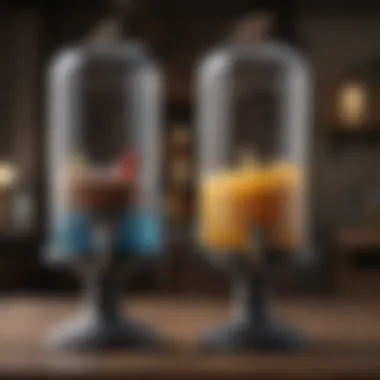
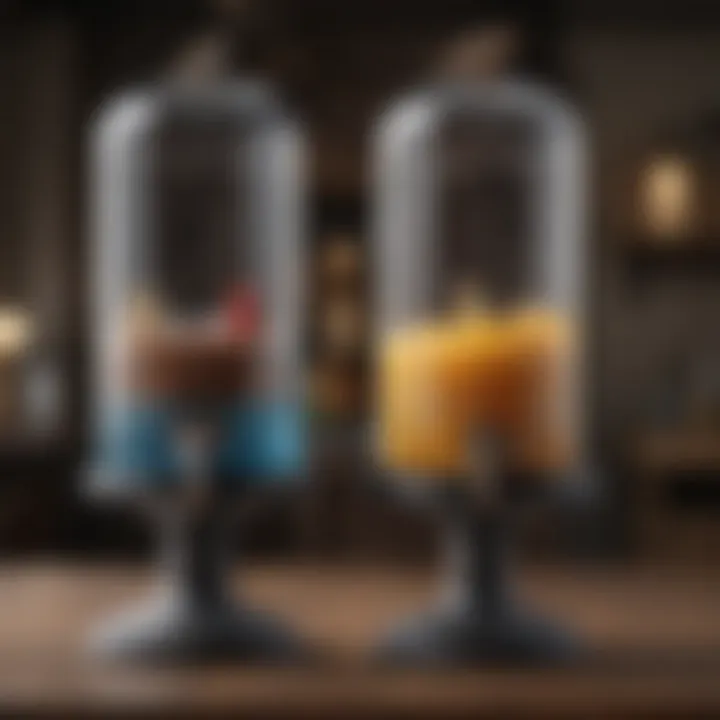
One of the primary benefits of using a cage cover is the control over light exposure. Birds have natural rhythms related to light, which affect their mood and behavior. Using a cover during dark hours can mimic night conditions, fostering healthy sleep patterns. This is particularly important for budgies and cockatiels, for example, who require about 10-12 hours of uninterrupted sleep each night.
Another advantage is the privacy that these covers provide. In the wild, birds seek safe spots where they can feel hidden and secure. A covered cage can create a cozy atmosphere, reducing stress during hectic moments when loud noises or sudden movements occur nearby.
Here are some notable benefits to consider:
- Natural Light Control: Helps in managing the amount of sunlight that penetrates the cage, keeping the bird comfortable.
- Stress Reduction: Acts as a shield against external disturbances, contributing to a tranquil environment.
- Temperature Regulation: Can retain warmth when necessary during colder months, adding an additional level of comfort.
Types of Cover Materials
Selecting the right materials for your cage cover is crucial. Many options exist, each with unique benefits and drawbacks. Understanding these choices allows bird owners to make the best selection for their companions.
Some common options include:
- Cotton: A popular choice due to its moderate thickness and breathability. This material is perfect for providing warmth while still allowing some air circulation.
- Fleece: Fleece covers are soft and warm, making them great for colder temperatures. However, they may not allow enough airflow.
- Mesh: Ideal for warmer climates, mesh covers prevent overheating by promoting optimal airflow while still offering partial cover.
When choosing a material, it's key to consider factors like durability, washability, and suitability for the climate. These elements will dictate how effective each cover will be in meeting your pet's specific needs.
“A proper cage cover can influence not just the health of a bird, but also its mood and activity levels.”
Climbing Structures
Importance of Climbing for Birds
Climbing structures play a vital role in the overall health and happiness of pet birds. In the wild, birds engage in climbing as part of their natural behavior, which helps to strengthen their muscles and keeps them mentally sharp. The lack of appropriate climbing opportunities can lead to boredom and stress in captive birds, resulting in behavioral problems such as feather plucking. Therefore, ensuring that birds have various climbing options is critical for their well-being. These structures not only meet the physical needs of birds but also encourage exploration and interaction within their environment.
Types of Climbing Structures
There are various types of climbing structures designed specifically for birds. Each type offers unique benefits which accommodate different species and their needs. Here are some popular options:
Ramps
Ramps provide a gentle incline, allowing birds easy access from one area of the cage to another.
Key Characteristic: Soft surfaces suitable for all types of birds.
Ramps can be constructed from materials such as wood or fabric with textured grips that prevent slips.
Benefits: These features help to accommodate birds with varying levels of agility. Ramps are particularly beneficial for older birds or those with limited mobility. On the downside, ramps need to be securely placed to prevent accidents.
Vines
Vines offer a natural climbing experience for birds.
Key Characteristic: Flexible and stretched materials mimic how birds would climb in the wild.
Providing grooved and textured vines keeps birds engaged and allows them to chew safely.
Advantages: This option also encourages exercise and exploration. However, it's important to ensure that fibers used are non-toxic and safe for chewing to avoid any harmful situations.
Bridges
Bridges allow birds to cross between sections of their cage, adding an element of adventure to their lives.
Key Characteristic: Elevated pathways that stimulate a bird’s curiosity.
Usually made from wood or rope, the slightly swinging motion challenges birds to balance and develop their coordination skills.
Advantages: Bridges promote active play; however, they require proper installation to ensure stability and safety, which makes regular checks essential to avoid accidents.
Incorporating climbing structures like ramps, vines, and bridges into a bird's habitat is essential to fulfilling their physical and mental needs. Each structure plays a significant role in stimulating healthy activities, providing enrichment, and fostering a positive attitude among avian pets.
Nesting Boxes and Areas
Why Nesting Areas Are Important
Nesting areas play a pivotal role in the overall well-being of pet birds. Birds are instinctively driven to nest, regardless of whether they are breeding. This natural behavior cannot be overlooked. Having an appropriate nesting space allows birds to feel secure and helps in reducing stress levels.
Moreover, these boxes provide an essential sanctuary for rest and comfort. Most birds thrive in environments that mimic their natural habitat. A nesting area can closely replicate these conditions, making pet birds feel more at home. It gives them a dedicated space to retreat, facilitating a sense of safety and privacy that is crucial for avian mental health.
Nesting areas also promote positive behaviors among birds. When they have a space that encourages the act of nesting, they enact instinctive behaviors that might include arranging some materials or simply resting. This can lead to overall fitness and contentment, crucial for their happiness.
Additionally, nesting areas may influence breeding behaviors. If owners intend to breed their birds, providing the proper environment becomes even more critical. The right nesting box can lead to a better reproductive outcome.
Choosing the Right Nesting Box
Selecting the appropriate nesting box can greatly affect a bird's health and happiness. Factors like species-specific requirements and individual preferences should guide this selection.
When choosing a nesting box, consider the following elements:
- Material: Wooden nesting boxes are often favored due to their familiarity and texture, which birds are used to in nature. Avoid toxic materials that can harm your pet.
- Sizing: The size of the nesting box should align with the size of the bird. A box that is too small can lead to discomfort, while one that is excessively large may sense less of a secure environment. This can make birds reluctant to use it.
- Dimensions: Ensure there are ventilation holes to maintain airflow, along with appropriate depth to prevent falling.
- Security: Boxes should have a secure latch or side entry. This ensures birds feel safe inside their box without excessive disturbances.
Specific combinations of heights and shapes will affect comfort. It's equally vital to consider the placement of nesting boxes within the cage. They should be placed at proper heights, providing flat surfaces for easy access.
Finding the right nesting box is more than just an addition to cage; it’s a fundamental element for promoting a healthy, enriching lifestyle for your feathered friend.
Safety Accessories
Safety accessories are vital in safeguarding the well-being of pet birds. Birds are naturally curious beings and, when unrestricted, they can encounter various types of danger. Essential safety measures can lead to a long, healthy life for your avian companion. Proper consideration to these elements can make a significant difference in preparing a safe habitat.
Toys Without Hazardous Parts
One of the most important components of a safe bird cage is the toys provided for the birds. When selecting toys, significantly focus on finding ones that are free from hazardous parts. Sharp edges or small detachable pieces can lead to injuries or accidental swallowing. Opt for toys made from strong, non-toxic materials. Climbing ropes and swings constructed of sisal or cotton are safer alternatives. Additionally, avoid toys painted with toxic colors, which could also pose health risks.
Some safe toy materials include:
- Natural wood: Look for untreated varieties; they provide chewing satisfaction while promoting mental stimulation.
- Big plastic and sisal: They lower risks of injury. Make sure these toys are large enough to prevent any ingestion.
- Cooperative to play with several birds: This enhances interpersonal interaction in Flod Flac environment.
Safety assessments of toys should be regular. Inspect them for wear and tear at least once a week, and replace any damaged items. The right toys contribute much to both your bird’s mental health and overall safety.
Secure Cage Locks
Cage security is another area that should not be neglected. Secure cage locks significantly prevent adventures that may lead to unfortunate incidents. Birds are adept at using their beaks and feet to unlock cages, so your choice of lock is key. Investing in lock designs specifically made for bird cages, such as carabiner-style clips or significantly lining them with roller mechanisms tend to offer best security.
When evaluating locks, consider the following:
- Durability: The lock should be sturdy enough to withstand repeated attempts from your bird.
- Ease of use: Select locks that you can easily operate by hand yet present a challenge for your bird.
- Reliable brand options: Research brands renowned for safety gadgets if unsure about what the reliable options are.
Grooming Accessories
Grooming accessories for pet birds are not simply optional add-ons. They play a key role in maintaining your bird's health and comfort. Regular grooming contributes to their overall well-being, reduces stress, and prevents problem behaviors related to insufficient care activities. Having the right tools readily available in your setup ensures that proper grooming becomes a part of the regular routine.
Nail Trimming Tools
Keeping your bird’s nails clip is essential. Overgrown nails can cause discomfort and lead to injuries. Nail trimming tools come in different forms. You have clippers, grinders, or even specialized scissors designed for bird nails. Each type offers a unique approach.
- Nail Clippers: These are popular and user-friendly. They should have rounded tips to reduce the risk of accidents. It’s important to choose one that suits your bird's size.
- Grinders: Electric alternatives provide smoother results compared to clippers, minimizing splintering. These require time for training your bird to get used to the noise and vibration.
Regular monitoring is needed. If unsure about the grooming process, seeking guidance from avian veterinarians helps avoid mistakes as bird nails go too close to the quick, which can cause bleeding.
Bird Baths and Mist Sprayers
A bird's health greatly benefits from proper bathing practices. Many pet owners are not aware of how important moisture is for their birds. Bird baths offer not just a form of hygiene, but are also enjoyable for the birds, providing an opportunity for play.
- Types of Baths: Choose between shallow dishes or specialized bathing containers. Ensure ease of access for birds both lover and high flying. The right water temperature is another concern; warm, but not too hot, water is more inviting.
- Mist Sprayers: Aside from baths, regular mist spraying mimics natural rain for birds. It adds water directly to their feathers while creating a soothing environment. Mist sprays can help relieve stress, especially when using them gently.
Avoid using tap water that contains chemicals. Instead, using filtered or distilled water enhances your bird's health.
By incorporating grooming accessories into your bird care routine, you are not only promoting health but also fostering a bond built on care and trust with your feathered friend.
Health Monitoring Supplies
Monitoring the health of pet birds is an essential responsibility for any owner. Health monitoring supplies can make a significant difference in identifying and addressing potential health issues before they escalate. Having the right tools empowers bird owners to act quickly, contributing to the well-being of their avian companions.
Besides offering tools for immediate health concerns, these supplies can also provide insights into the overall health of birds. This section diels into what contributes to effective health monitoring, specifically focusing on first aid kits and weight/temperature monitoring tools, essential aspects that ensure ongoing care.
First Aid Kit Components
Every bird owner should prepare for emergencies by assembling a thorough first aid kit. This kit should include components that cater specifically to the unique needs of birds. Some essential items to include are:
- Sterile gauze: For controlling bleeding and dressing wounds.
- Antiseptic liquid: Such as Betadine or a bird-safe solution to clean wounds and prevent infections.
- Tweezers: Useful for removing splinters or other foreign materials.
- Jamesarclamp CV for clotting if necessary.
- Non-stick bandages: While these are not only safe but also reduce fear during removal for the bird.
- Ivy dome thermometer: To check body temperatures accurately.
- Books or pamphlets about bird first aid, weight charts, and emergency care.
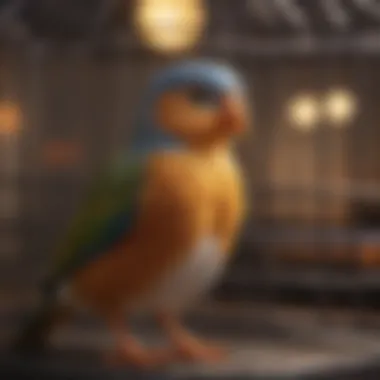
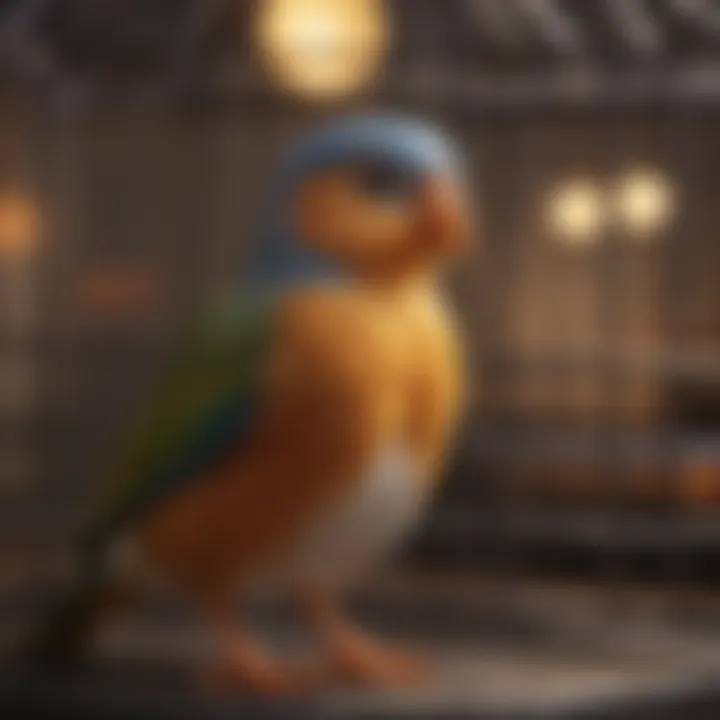
A first aid kit can be a lifeline during an emergency. Having it readily available significantly increases a bird’s chances of recovery.
Investing time into understanding avian first aid can save lives.
Weight and Temperature Monitoring Tools
Tracking a bird's weight and temperature at home can reveal crucial information about his or her health status. Birds are generally delicate, and subtle changes can indicate larger concerns. Suggested tools for these vital monitoring tasks include:
- Digital scale: Create a routine for weighing your pet bird a least weekly to spot any unexpected weight fluctuations, which might indicate stress or illness. It's most effective to use a digital scale designed for small animals to ensure accurate readings.
- Infrared thermometer: A simple non-invasive method to monitor a bird's body temperature. Ideal body temperature for many birds is between 104°F to 107°F.
Regular monitoring not only helps identify health concerns but can also facilitate wellness. Consistent tracking allows owners to become familiar with their pet's normal behaviors and metrics. By addressing health monitoring affordably through simple supplies, diligent owners can invest in the future of their cherished birds.
Environmental Enrichment Tools
Environmental enrichment plays an essential role in maintaining the health and happiness of pet birds. These tools help to mitigate the monotony of a confined space, offering both physical and mental stimulation. Birds thrive in a lively environment that mimics their natural habitat. The key benefit of enrichment tools is that they fulfill the innate needs of birds to forage, explore, and engage in various activities, which is fundamental for their emotional well-being.
Utilizing a range of enrichment items not only improves their quality of life but also assists in reducing harmful behaviors such as feather plucking or aggressive tendencies. Each pet bird species has its own specific needs, making it necessary for bird owners to assess which enrichment tools align well with the characteristics and preferences of their birds.
Types of Enrichment Items
Environmental enrichment can take various forms, and some popular types of enrichment items include:
- Foraging Toys: Encourages natural foraging behavior, where birds search for treats hidden inside toys. This not only engages them but also adds physical activity.
- Interactive Toys: Toys that respond to the bird's actions encourage engagement and critical thinking. They come in different shapes and functions.
- Climbing Structures: Offering physical challenges while also providing a fun way for birds to exercise and explore.
- Hanging Entertainment: Treats or toys suspended from the cage ceiling. This scaffold can entice birds to stretch and reach, encouraging more active movement.
Comparatively, adopting innovative designs with vibrant colors can further enhance engagement.
Incorporating Natural Elements
Incorporating natural elements in the bird's habitat aids in mimicking their native environment and offers various advantages. Plants, branches, and other organic materials provide an authentic experience for the bird. Using natural twigs, for instance, can also serve as perches. Natural wood materials allow your birds to satisfy their instinctive urge to gnaw traversing natural surfaces.
When choosing natural elements:
- Ensure Safety: Avoid toxic plants. Select non-treated branches free from chemicals.
- Diverse Sizes: Provide a variety of textures and dimensions to thoroughly engage your bird. Make sure there are multiple layer of complexity with suitable grips for their feet.
- Placement Variety: Regular rearrangement of elements keeps their habitat intriguing and supports ongoing exploration.
Observing your bird adapt can be rewarding while fostering an encouraging environment which greatly benefits their spirits. Overall, environmental enrichment tools form an integral part of any bird owner’s toolkit and provide both challenges and enjoyment.
Choosing the Right Accessories for Your Bird
Choosing the right accessories for your bird is crucial. Incorrect choices can harm your pet's health or lower its comfort. Birds have unique needs based on individual species, environment, and behavior. Understanding these needs helps prioritize accessories that best suit your avian friend.
Accessories are not merely decorative elements; they fulfill essential functions. Inadequate or inappropriate items can result in stress or health issues. Most importantly, some species require specific perches, toys, and other items that cater to their natural instincts. All of this reinforces the importance of thorough research and assessment for optimal bird care.
Assessing Species-Specific Needs
Bird species vary greatly in size, personality, and requirements. For example, small birds like parakeets have different needs compared to larger birds like cockatoos. Owners should first identify their bird’s species, as this is crucial in choosing supplies. When selecting accessories, consider:
- Perch size and shape: Smaller species may favor thinner or softer perches.exe
- Toys for mental enrichment: Different breeds tend to prefer different types of stimuli. Large parrots often enjoy puzzle toys, while a finch might prefer small, colorful objects to interact with.
- Nesting necessities: Some species, like canaries, appreciate nesting materials, while others may not need these.
Additionally, understanding a bird's natural habitat aids in providing a suitable environment. For instance, a lovebird enjoys climbing, while a budgie may prefer to flit between perches. It's crucial to note these species-specific features before buying new accessories.
Considerations for Cage Size and Layout
Cage sizes vary, and they profoundly affect the accessories that can be used. The layout inside the cage also holds significance. As a general rule, the cage should be spacious enough to allow freedom of movement and flight.
When determining anything inside the cage:
- Distribution of pieces: Place perches strategically to allow birds to roost comfortably without crowding. A mix of heights and distances lets birds channel their natural instincts.
- Choosing accessories based on height: Ensure each item fits properly. High elevation should align with climbing favorites, while lower points cater to resting birds.
- Maintenance: Remember the cleaning aspect. Open layouts can make maintenance easier while providing stimulating movement options.
To summarize, the accessibility around the cage is highly intertwined with bird happiness, well-being, and overall experience.
Optimal accessory choices enhance not only comfort but also a vibrant, stimulating environment to nurture healthy and happy birds.
Maintenance of Cage Accessories
Maintaining cage accessories is crucial for the health and well-being of pet birds. Clean and functional items contribute to a safer and more enjoyable living environment. Every accessory, from perches to toys and food dishes, can accumulate waste, bacteria, and wear over time. Regular maintenance ensures their longevity and effectiveness, leading to happier birds.
Cleaning and Hygiene Protocols
Establishing a robust cleaning routine is vital in maintaining hygiene within a bird's cage. Regular cleaning prevents the buildup of harmful bacteria that could affect a bird’s health. Here are key considerations for effective cleaning:
- Frequency: Establish a cleaning schedule that suits your bird's environment. Daily activities might include spot cleaning, while a more thorough cleaning can be done weekly.
- Safe Products: Use bird-safe cleaners made from natural ingredients. Avoid chemical cleaners that can poison or irritate birds.
- Removing Accessories: When cleaning, take the accessories out of the cage. This allows for a more comprehensive cleaning of surfaces, preventing hidden grime.
- Scrubbing: Use brushes to clean hard-to-reach areas, like corners and between bars. Pay extra attention to food and water dishes, as these need to be sanitized frequently.
Incorporating these practices creates a healthier habitat that supports your pet bird's immune system and reduces illness risk.
Regular Checks for Wear and Tear
Ongoing inspection of cage accessories plays an equally important role in maintenance. Items can suffer from chipping, cracking, or general wear after consistent use. Here are some tips for assessing your bird’s accessories:
- Visual Inspection: Regularly check accessories for any signs of damage. Look at perches for fraying and check toys for broken parts destined to be munched on.
- Stress Points: Examine areas where accessories connect to the cage; fastening pieces can wear off or break easily. Make sure everything is properly secured.
- Interchangeability: Regularly rotate out toys or change up perches to give your bird new experiences and to also distribute wear evenly among accessories.
- Replacement Criteria: Know when to retire an item. If an accessory poses a safety risk due to deterioration, replacing it is essential for your bird's well-being.
Creates a rewarding living space that addresses both comfort and safety for our avian companions. Regular checks save time and expense in the long run, reducing potential medical concerns.
“A clean and well-maintained environment is fundamental in fostering your pet bird’s health and happiness.”
Sourcing Quality Accessories
Sourcing quality accessories is crucial when creating a conducive environment for your pet bird. The right accessories not only enhance the aesthetics of the cage but also ensure the safety, comfort, and well-being of your feathered companion. Giving attention to this area can help prevent various health issues that can arise from improperly sourced items.
When considering accessories, it is vital to explore several elements that guarantee product quality and safety. You should prioritize the materials used, checking for non-toxic substances free from chemicals. This is non-negotiable. Poor-quality materials can introduce harmful components that may be ingested. Additionally, evaluate the durability of the products. Your pet bird will spend considerable time on perches, toys, and liners, so they should withstand daily usage without eroding or breaking down.
Another benefit of sourcing quality accessories is environmental enrichment. High-quality products can stimulate mental engagement and physical activity. Successful enrichment can lead to happier, healthier birds, which is a notable goal for any pet bird owner.
Importantly, quality accessories contribute to long-term cost-effectiveness. Investing in durable fou accessories may seem expensive upfront, but they will likely save you money by reducing the need for frequent replacements.
Evaluating Product Quality and Safety
When evaluating the quality and safety of potential accessories, take into account several critical factors:
- Material Composition: Ensure any wooden or plastic items meet safety standards. Look for certifications or mention of bird-friendly ratings.
- Construction: Check for any weak spots or possible sharp areas. Products should exhibit robust construction, free of loose parts that can be hazardous to your bird.
- User Reviews: Examination of customer feedback can provide valuable insights into the actual condition and usability of the products.
Each of these factors plays a significant role in informing your decisions. Ensuring top quality items will directly translate to better overall care for your bird.
Reputable Brands to Consider
Choosing reliable brands can substantially mitigate risks. Some well-respected brands specializing in bird accessories include Zupreem, Kaytee, and Prevue Pet Products. These brands have established a reputation for safety and quality in pet bird supplies.
- Zupreem: Known for its nutritious food and complementary toys, Zupreem offers a wide range of products suitable for different bird species.
- Kaytee: This brand appears prominently in bird care, manufacturing not only food but a variety of toys and accessories designed to foster play and engagement.
- Prevue Pet Products: With a large selection of cages and accessories, Prevue Pet Products is trusted for designing bird-safe items that endure daily use.
By focusing on well-established brands, you can reduce the time spent searching for quality accessories. Thus ensuring you're choosing reliable products that cater to your bird's physical and psychological well-being.
Always read labels and product descriptions carefully to identify materials and construction before making any purchase.
The End
Understanding the essentials of pet bird cage accessories plays a crucial role in the overall well-being of avian companions. These accessories not only cater to a bird's basic needs but also foster a stimulating environment that encourages natural behaviors. Safety, environmental enrichment, and comfort remain fundamental elements that should not be overlooked. Each component, whether it be perches, toys, or nesting areas, contributes uniquely to psychological health and physical vitality of the bird.
Additionally, pet bird owners must consider species-specific requirements. A parakeet's need for spaces to explore, for instance, may differ from those of a larger parrot. Knowing these unique demands is essential for promoting a thriving habitat.
An engaging and nurturing environment helps mitigate behavioral issues, builds confidence, and ensures longevity for pet birds.
Summary of Key Points
- Pet bird accessories encompass a range of elements crucial for health and happiness.
- Safety in the design and materials of these accessories prevents injuries.
- Regular maintenance must be prioritized to ensure hygiene and safety.
- Species-specific needs should guide the selection of accessories to enhance comfort and enrichment.
- Environmental enrichment is vital for mental stimulation, allowing birds space and activities that promote physical exercise and cognitive growth.
Encouragement for Thoughtful Choices
Choosing the right accessories for your pet bird demands thoughtful consideration. Reflect on the specific needs of your bird species and guarantee that the items meet those needs effectively. Quality trumps quantity; investing in durable accessories not only ensures safety but also enhances a bird's quality of life. Through research on reputable brands, pet owners can procure accessories that enrich and satisfy their bird’s intrinsic habits.
In your journey as a bird owner, it’s important to continually reassess and adapt your approach to their environment. Make a habit of checking the tools you provide — replacing or updating them as needed. Thoughtful choice making in regard to accessory selection will lead to a happy and healthy avian companion.















